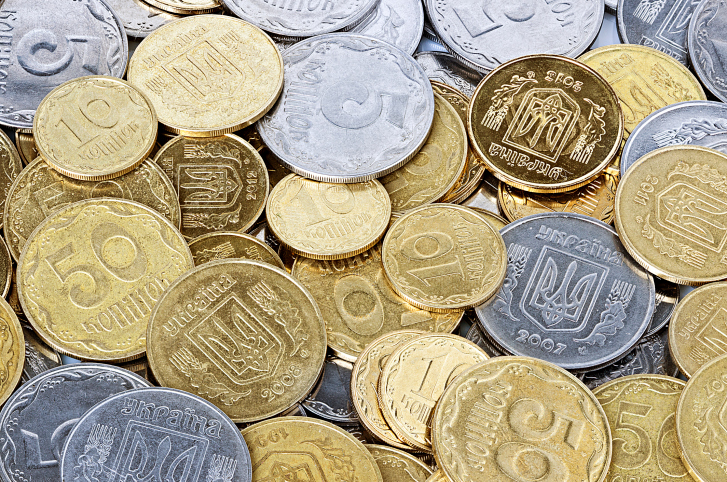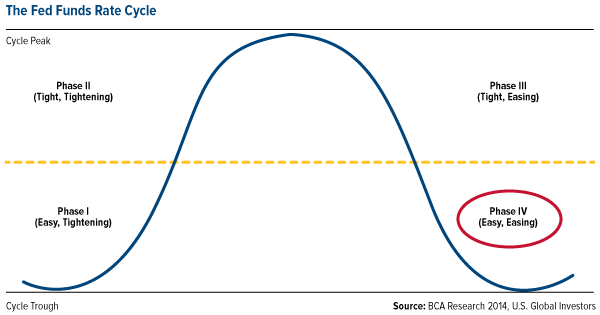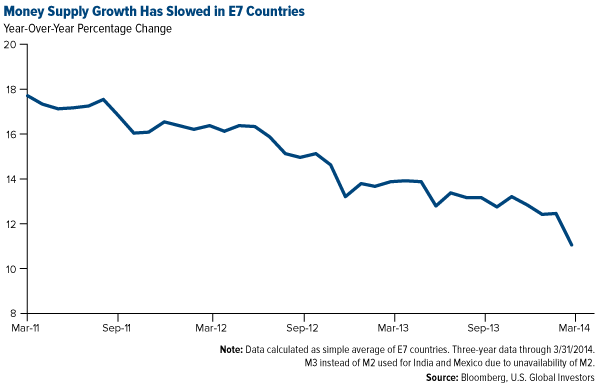Gold & Precious Metals
Why Gold & Silver Are Soaring
Posted by Ben Kramer-Miller - Wall Steet Cheat Sheet
on Monday, 23 June 2014 11:11
 Gold and silver have had phenomenal weeks, with the metals rising nearly 3 percent and 6 percent, respectively. Many columnists are claiming that this is due to escalating tensions in Iraq and the rising possibility that the Iraqi state will enter a state of chaos.
Gold and silver have had phenomenal weeks, with the metals rising nearly 3 percent and 6 percent, respectively. Many columnists are claiming that this is due to escalating tensions in Iraq and the rising possibility that the Iraqi state will enter a state of chaos.
But this really isn’t the case, or it is in the same way that the assassination of the Archduke Ferdinand “caused” World War 1: It was the trigger, but in itself it was not the driving force behind the war. So perhaps there are some speculators that bought gold this week because they are concerned that political tensions in Iraq will escalate, but there are deeper factors driving the price that have been driving the price higher for many years now. Only those investors who understand this will have the confidence to buy gold when the market is weak, or when geopolitical tensions in Iraq (or anywhere for that matter) dissipate.
The price of gold has been rising for several fundamental reasons. The first is…continue reading HERE
#2 Most Viewed Article: Silver To $65 On Historic Breakout
Posted by King World News
on Saturday, 21 June 2014 13:30
 Today KWN is putting out a special piece which features a chart showing a historic breakout in the price of silver. This is the type of chart that the big banks follow closely, as well as big money and savvy professionals. David P. out of Europe sent us the astonishing silver chart that all KWN readers around the world need to see.
Today KWN is putting out a special piece which features a chart showing a historic breakout in the price of silver. This is the type of chart that the big banks follow closely, as well as big money and savvy professionals. David P. out of Europe sent us the astonishing silver chart that all KWN readers around the world need to see.
Below is the extraordinary silver chart sent to KWN by David P. out of Europe along with his commentary.
…larger chart & commentary HERE
#3 Most Viewed Article: Gold Investors: Let This Cycle Be Your Guide
Posted by Frank Holmes CEO & Chief Investment Officer U.S. Global Investors
on Saturday, 21 June 2014 13:20
U.S. Global Investors recently welcomed Doug Peta, an economist from BCA research, to our offices. He presented some interesting research regarding the Fed Funds Rate Cycle, and in turn, what that research could mean for gold. I wanted to share points from his presentation, as well as our own in-house research, to help you understand the positivity we see for the precious metal looking towards 2015.
Where are we now?
Below is a chart from BCA showing the Fed Funds Rate Cycle. In essence, this chart neatly illustrates what the interest rate cycle imposed by the U.S. Federal Reserve looks like. The red circle indicates where we are right now: Phase IV, also known as the “easing” phase of the monetary policy that was enacted in 2008 in the U.S., better known as quantitative easing (QE).

As we know, the Fed enacted QE to stimulate our nation’s economy. Right now we’re benefitting from our placement in Phase IV of this cycle because it is in this phase that the Fed is able to keep interest rates low, keep reserve requirements low and continue printing money. Similarly, when money is “easy,” businesses can find funding for projects and consumers have easier access to credit.
Historically, Phase IV (as well as the shift towards Phase I) are the best for equity investors because stocks usually rise during these two positions in the cycle.
Why these phases are good for gold, too.
We have been in Phase IV of the Fed Funds Rate Cycle for a few years now, and are expected to remain here into 2015. Eventually the Fed will have to start tightening again and raise rates, although the numbers should remain relatively low for a while. Once this begins, we will move into Phase I.
When it comes to the performance of gold and gold stocks, history indicates good times are ahead based on where we are in the cycle. Take a look at the tables below showing median returns during the cycle dating back to 1970 and 1971. You’ll see that for gold and gold stocks, Phase IV and Phase I both show the highest median returns.
| Spot Gold, From June 1971 | TSE Gold Miners, From July 1970 | ||
|---|---|---|---|
| Phase | Median | Phase | Median |
| Phase I (Easy, Hiking) | 11.8% | Phase I (Easy, Hiking) | 16.2% |
| Phase II (Tight, Hiking) | 2.2% | Phase II (Tight, Hiking) | -8.8% |
| Phase III (Tight, Cutting) | -4.3% | Phase III (Tight, Cutting) | -15.9% |
| Pase IV (Easy, Cutting) | 9.2% | Phase IV (Easy, Cutting) | 24.2% |
Note: Excluding the two-month Phase II period spanning the October ’87 stock market crash.
The reason for the high returns during these two phases is because of “easy money.” Tight money, which is what Phase II and III are based upon, is typically bad for gold investors. When money is tight, we don’t have inflation, and investors don’t need to turn to gold as a hedge against inflation. Without inflation there is no need to hedge.
Another reason we’ve traditionally seen gold investors benefitting during Phases IV and I of the cycle is that when money is easy, interest rates are low, meaning less opportunity cost for holding the precious metal. To help illustrate, imagine putting your money in a savings account and earning 5 percent on it. Well, the opportunity cost of keeping gold under your mattress would be giving up that 5 percent that you could be earning elsewhere. When your savings account yields next to nothing, some reason, why not just buy some gold?
This pattern is worldwide.
The trends we see in the Fed Funds Rate Cycle are not only U.S. specific. This same idea carries through to the stimulative policies of the European Central Bank and Japan. More countries around the world are applying monetary stimulus programs much like the U.S., while moving away from more restrictive policies. Remember that restrictive policies relate to tightening, which is bad for gold, and stimulative policies relate to easing, which is good for gold.
Right now, gold could use a pick-me-up, and here’s why. Over the last several years we’ve seen slowing money supply growth in many E7 countries. E7 refers to seven countries with emerging economies including China, India, Brazil, Mexico, Russia, Indonesia and Turkey. It’s these countries that drive the Love Trade for gold, primarily China and India, which purchase the metal for religious and cultural celebrations.

With less money being spent or borrowed, not only did the Love Trade begin to slow, global GDP growth also began to slow as you can see below.

The good news is, as we see various countries applying monetary stimulus, including emerging markets, we can expect this to contribute to global GDP growth. In 2014, global GDP is expected to grow by 3.2 percent, according to the World Bank’s latest projections.
Similarly, the money supply of the United States has been a steady grower and the money supply in the E7 countries is also expected to reverse course; right now it is growing again but at a slower rate. The U.S. data suggests that a new easing cycle is starting in Europe, Japan and emerging markets. A pickup in economic activity in the E7, especially the big gold consumers, is yet another positive sign for the yellow metal.
Real interest rates are headed lower for most of the world as well. As money supply grows, countries eventually feel inflationary pressures. This will hold true in the U.S. as we move into 2015 and back into Phase I. All of these changes can lead to a declining confidence in paper money, yet another good sign for gold.
An interesting side note.
I have noticed that recent articles in both Money Magazine and the New York Times use an array of gold images to illustrate wealth. It seems that while some may debate whether gold is money, gold remains an enduring symbol of wealth.
Super Force Precious Metals Video Analysis
posted Jun 20, 2014
“Our main format is now video analysis…”
Here are today’s videos:
Gold Breakout Charts Analysis
Silver $26 Target Charts Analysis
GDX Pause & Pop Charts Analysis
GDXJ Bull Flag Charts Analysis
Thanks,
Morris
The SuperForce Proprietary SURGE index SIGNALS:
25 Surge Index Buy or 25 Surge Index Sell: Solid Power.
50 Surge Index Buy or 50 Surge Index Sell: Stronger Power.
75 Surge Index Buy or 75 Surge Index Sell: Maximum Power.
100 Surge Index Buy or 100 Surge Index Sell: “Over The Top” Power.
Stay alert for our surge signals, sent by email to subscribers, for both the daily charts on Super Force Signals at www.superforcesignals.com and for the 60 minute charts atwww.superforce60.com
About Super Force Signals:
Our Surge Index Signals are created thru our proprietary blend of the highest quality technical analysis and many years of successful business building. We are two business owners with excellent synergy. We understand risk and reward. Our subscribers are generally successfully business owners, people like yourself with speculative funds, looking for serious management of your risk and reward in the market.
Frank Johnson: Executive Editor, Macro Risk Manager.
Morris Hubbartt: Chief Market Analyst, Trading Risk Specialist.
website: www.superforcesignals.com
email: trading@superforcesignals.com
email: trading@superforce60.com
SFS Web Services
1170 Bay Street, Suite #143
Toronto, Ontario, M5S 2B4
Canada
###
Jun 20, 2014
Morris Hubbartt
Gold Price On Insane Surge After Massive Trade
Posted by Mining.com via IRVancouver
on Friday, 20 June 2014 9:38
The gold price scaled $1,300 an ounce for the first time in more than a month, after comments by US Federal Reserve chair Janet Yellen yesterday and a huge buyer lit a fire under traders.
On the Comex division of the New York Mercantile Exchange, gold futures for August delivery – the most active contract – jumped to a day high of $1,322.00 an ounce, up $49.30 or nearly 4% from yesterday’s close.
After months of subdued trade on gold futures markets volumes surged on Thursday leaping past 210,000 contracts – double recent daily averages – by mid-afternoon.
As the chart shows….continue reading HERE

….continue reading HERE
Hat tip Investor Relations Vancouver
-
I know Mike is a very solid investor and respect his opinions very much. So if he says pay attention to this or that - I will.
~ Dale G.
-
I've started managing my own investments so view Michael's site as a one-stop shop from which to get information and perspectives.
~ Dave E.
-
Michael offers easy reading, honest, common sense information that anyone can use in a practical manner.
~ der_al.
-
A sane voice in a scrambled investment world.
~ Ed R.
Inside Edge Pro Contributors

Greg Weldon

Josef Schachter

Tyler Bollhorn

Ryan Irvine

Paul Beattie

Martin Straith

Patrick Ceresna

Mark Leibovit

James Thorne

Victor Adair



